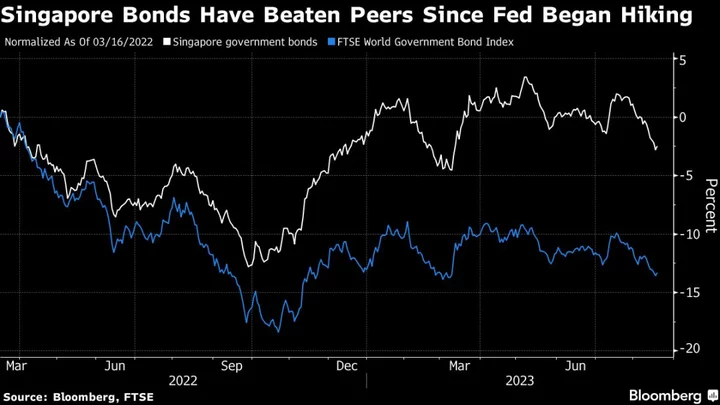Singapore’s government bonds are attractive as a haven from the mounting economic problems in China and a hawkish Federal Reserve that’s prepared to keep raising interest rates, according to Fidelity International.
The city-state’s debt is alluring due to its relatively attractive yields, robust currency and AAA credit rating, said Lei Zhu, head of Asian fixed income in Hong Kong at the money manager, which oversees $745 billion. Singapore’s debt should also benefit as the nation’s relatively low deposit rates give local banks an incentive to put funds into the higher-yielding government securities, she said.
“The front end is almost 4% and the domestic market is relatively small in terms of the size versus the massive inflow and demand,” Zhu said in an interview last week. “So naturally the assets are quite sought after because Singapore is selling its safe-haven status. It’s a parking place and we are quite bullish on the duration and foreign exchange.”
Singapore’s local-currency government bonds have lost just 2.5% since the Fed started its tightening cycle on March 16 last year, while the world government bond index has slumped 13.3% over the same period, according to data compiled by Bloomberg.
Financial Hub
The island’s status as Southeast Asia’s premier financial hub means it can provide investors with a shelter from external headwinds and it’s also a beneficiary of shifting global supply chains, Zhu said.
Fidelity’s clients have become more interested in exposure to Singapore assets as US Treasuries have slumped over the past four months, while China’s worsening economic outlook has sapped risk sentiment, she said.
“If interest rates stay higher for longer, then the chance of recession and the magnitude will be even bigger,” Zhu said. “It’s just a matter of time that interest rates at this level will have some kind of impact on the economy, so that’s why people are looking for safety.”
Fidelity is also positive on the sovereign debt of Indonesia and China, Zhu said.
(Adds view on Indonesia, China bonds in last paragraph.)









